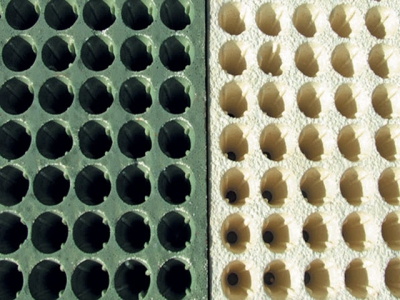Seedlings and seedling trays

Some farmers think that seedlings should not be kept too long because they will not be as productive. They are partly right, but age matters less than physiological development.
These new seedling trays were placed outdoors after the one on the left was painted. After many months, the wear is evident on the unpainted tray. Photo: Bill Kerr
I learnt about the distinction between age and development in the days before cavity seedlings.
We made seedbeds in the soil instead, and when pulling the plants for transplanting, we would occasionally find smaller plants. Their growth had been suppressed by competition from larger, stronger plants.
If we ran out of ‘good’ seedlings, we would later return reluctantly to the seedbeds and the pale, undernourished plants left behind.
We did not know it at the time, but these plants were in limbo as they were not being fertilised or looked after any more. However, to our surprise they would end up performing just as well as the others.
So, how can you tell whether a smaller seedling will produce a healthy adult plant? The answer is to look for those seedlings that have continued to develop new leaves, no matter how small. The leaf count should be about the same as their bigger, more robust cousins.
It is this that matters, not the overall condition of the plant. (I have discussed how seedlings go into limbo in a previous column).
Age of the plant
Development can also be affected by temperature. In midsummer, a plant may reach transplant size in four weeks, whereas it may take eight weeks in cold weather.
Choosing seedling trays
The size of the seedling cavities must also be considered. The most popular size is the 200-cavity seed tray, but many seedling growers also offer seedlings in 300-cavity trays, with each cavity being smaller.
Trays with 128 cavities are used for seedlings that require more room and growing medium.
The number of cavities in the tray affects costs. The 300-cavity tray enables 50% more seedlings to be grown in a given space than a 200-cavity tray.
This saves money on trays as well as making better use of nursery space. Also, each cavity contains less growing medium.
Plants growing in smaller cavities should be smaller than those in larger cavities, as the larger the seedling, the more water it extracts from the growing medium and the sooner it will suffer drought stress after transplanting.
More care is thus required with bigger seedlings.
Even the shape of the cavity plays a role. A square cavity will hold more growing medium than a round one.
The difference in growth can be seen where square and round trays are planted together.
The extra medium in the former produces faster growth under the right conditions. The downside is that square cavities have thinner walls between cells and are more liable to break when handled.
Longer life
Seedling trays are expensive. When you buy a new batch, dip them in roof paint before use. Make a flat dipping container.
Then, after diluting the paint with 10% to 20% water, push the trays cavity-side down into the paint so that the paint just reaches the holes leading to the bottom. Allow the excess paint to drip back into the container and place the trays in a suitable spot to dry.
This extends their life considerably and also coats the inside of the cavities to seal the porous surface, making them easier to sterilise. It also makes them smoother, so that the seedlings can be lifted out more easily.
Có thể bạn quan tâm
Phần mềm

Phối trộn thức ăn chăn nuôi

Pha dung dịch thủy canh

Định mức cho tôm ăn

Phối trộn phân bón NPK

Xác định tỷ lệ tôm sống

Chuyển đổi đơn vị phân bón

Xác định công suất sục khí

Chuyển đổi đơn vị tôm

Tính diện tích nhà kính

Tính thể tích ao hồ



 Striving for a happy medium
Striving for a happy medium  Hardening vegetable seedlings
Hardening vegetable seedlings